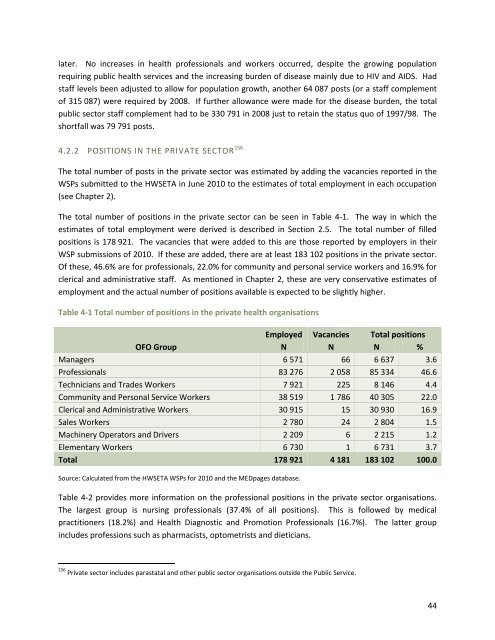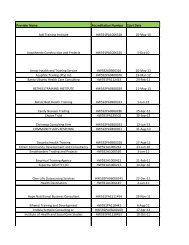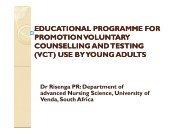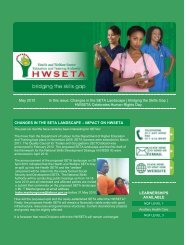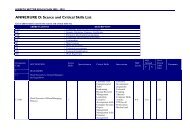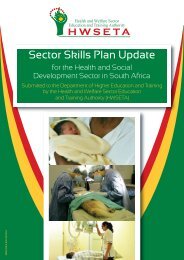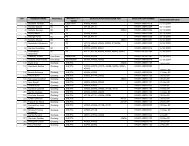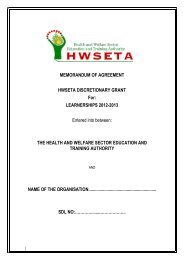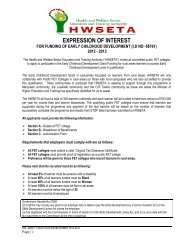sector skills plan for the health sector in south africa
sector skills plan for the health sector in south africa
sector skills plan for the health sector in south africa
You also want an ePaper? Increase the reach of your titles
YUMPU automatically turns print PDFs into web optimized ePapers that Google loves.
later. No <strong>in</strong>creases <strong>in</strong> <strong>health</strong> professionals and workers occurred, despite <strong>the</strong> grow<strong>in</strong>g population<br />
requir<strong>in</strong>g public <strong>health</strong> services and <strong>the</strong> <strong>in</strong>creas<strong>in</strong>g burden of disease ma<strong>in</strong>ly due to HIV and AIDS. Had<br />
staff levels been adjusted to allow <strong>for</strong> population growth, ano<strong>the</strong>r 64 087 posts (or a staff complement<br />
of 315 087) were required by 2008. If fur<strong>the</strong>r allowance were made <strong>for</strong> <strong>the</strong> disease burden, <strong>the</strong> total<br />
public <strong>sector</strong> staff complement had to be 330 791 <strong>in</strong> 2008 just to reta<strong>in</strong> <strong>the</strong> status quo of 1997/98. The<br />
shortfall was 79 791 posts.<br />
4.2.2 POSITIONS IN THE PRIVATE SECTOR 156<br />
The total number of posts <strong>in</strong> <strong>the</strong> private <strong>sector</strong> was estimated by add<strong>in</strong>g <strong>the</strong> vacancies reported <strong>in</strong> <strong>the</strong><br />
WSPs submitted to <strong>the</strong> HWSETA <strong>in</strong> June 2010 to <strong>the</strong> estimates of total employment <strong>in</strong> each occupation<br />
(see Chapter 2).<br />
The total number of positions <strong>in</strong> <strong>the</strong> private <strong>sector</strong> can be seen <strong>in</strong> Table 4-1. The way <strong>in</strong> which <strong>the</strong><br />
estimates of total employment were derived is described <strong>in</strong> Section 2.5. The total number of filled<br />
positions is 178 921. The vacancies that were added to this are those reported by employers <strong>in</strong> <strong>the</strong>ir<br />
WSP submissions of 2010. If <strong>the</strong>se are added, <strong>the</strong>re are at least 183 102 positions <strong>in</strong> <strong>the</strong> private <strong>sector</strong>.<br />
Of <strong>the</strong>se, 46.6% are <strong>for</strong> professionals, 22.0% <strong>for</strong> community and personal service workers and 16.9% <strong>for</strong><br />
clerical and adm<strong>in</strong>istrative staff. As mentioned <strong>in</strong> Chapter 2, <strong>the</strong>se are very conservative estimates of<br />
employment and <strong>the</strong> actual number of positions available is expected to be slightly higher.<br />
Table 4-1 Total number of positions <strong>in</strong> <strong>the</strong> private <strong>health</strong> organisations<br />
Employed Vacancies Total positions<br />
OFO Group<br />
N N N %<br />
Managers 6 571 66 6 637 3.6<br />
Professionals 83 276 2 058 85 334 46.6<br />
Technicians and Trades Workers 7 921 225 8 146 4.4<br />
Community and Personal Service Workers 38 519 1 786 40 305 22.0<br />
Clerical and Adm<strong>in</strong>istrative Workers 30 915 15 30 930 16.9<br />
Sales Workers 2 780 24 2 804 1.5<br />
Mach<strong>in</strong>ery Operators and Drivers 2 209 6 2 215 1.2<br />
Elementary Workers 6 730 1 6 731 3.7<br />
Total 178 921 4 181 183 102 100.0<br />
Source: Calculated from <strong>the</strong> HWSETA WSPs <strong>for</strong> 2010 and <strong>the</strong> MEDpages database.<br />
Table 4-2 provides more <strong>in</strong><strong>for</strong>mation on <strong>the</strong> professional positions <strong>in</strong> <strong>the</strong> private <strong>sector</strong> organisations.<br />
The largest group is nurs<strong>in</strong>g professionals (37.4% of all positions). This is followed by medical<br />
practitioners (18.2%) and Health Diagnostic and Promotion Professionals (16.7%). The latter group<br />
<strong>in</strong>cludes professions such as pharmacists, optometrists and dieticians.<br />
156 Private <strong>sector</strong> <strong>in</strong>cludes parastatal and o<strong>the</strong>r public <strong>sector</strong> organisations outside <strong>the</strong> Public Service.<br />
44


